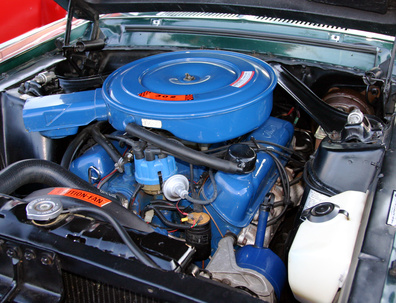
The ignition coil, sometimes called the coil pack on high-energy ignition systems, has the responsibility of supplying maximum voltage to the spark plugs in order for them to fire. Coils have primary and secondary windings inside them. The smaller primary winding sends a magnetic signal to the larger secondary windings, increasing the voltage from 12 volts up to as many as 50,000 volts. An ignition coil that begins to fail might show some early warning signs. A complete coil failure will not supply any voltage and will keep the vehicle from running.
One symptom of a faulty coil will show itself with an engine that misfires occasionally, bogs down and starts up again, or cuts out altogether. If the engine cuts out temporarily while the vehicle travels over rough terrain or hits bumps, this could be a sign the coil wire connections or the high-tension wire have been loosened from their connection points. One thin positive wire and one thin negative wire hook up to the face of the coil by small eyelets and tiny nuts. The negative wire connects to ground while the other wire receives battery voltage. Both connections should be clean and tight.
A weak or sporadic spark coming from the high-tension wire that exits the coil and connects to the distributor cap top pole can become loose, have high resistance or have corrosion problems at either of the connection points. A vehicle that has sluggish power (weak spark condition) can run at lower rpm, but suddenly cut or die out completely at higher speeds. A high tension wire that burns or has shorted out completely can cause a no-start condition. The high tension wire should be checked for high resistance with an ohm meter. Any resistance found indicates a bad wire and should be replaced. Simply swapping out the old high tension wire with a good one can test for this problem.
Ignition coils have interior jackets that hold a fine oil which cools the inner high-voltage armature windings. A coil that has excessively overheated can boil this cooling oil and burst through the outing coil casing. Wet, oil-soaked coils means the coil has overheated and melted the casing. Coils that overheat, without bursting the casing, can be extremely hot to the touch and eventually leak. Such coils must be replaced since the damage cannot be repaired.
To check for a no-start condition, disconnect the high tension wire at the distributor. Connect a spark plug to the end of this wire. Use a piece of extra wire to screw onto the threads of the spark plug (make sure you splice off enough bare wire to wrap it around the threads). Remove the thin ground wire from the coil face (it should be a green wire). Connect the other end of the spark plug ground wire to the coil's negative terminal, and then turn the key to the "ON" position–not the "start" position. Now tap the opposite end of the negative coil wire (the jumper wire) onto a good grounding surface, like the block or the negative battery terminal post. Look for hot, blue-white sparks at the spark plug electrode every time you tap. No sparks at all indicates a shorted coil. Yellow sparks indicate a very weak and failing coil.
A weak ignition coil spark will produce less voltage. Less voltage means that the spark plugs will not be able to burn the fuel mixture efficiently. This symptom can produce black, unburned fuel seen at the tail pipe, as well as hard starting and bad fuel economy.